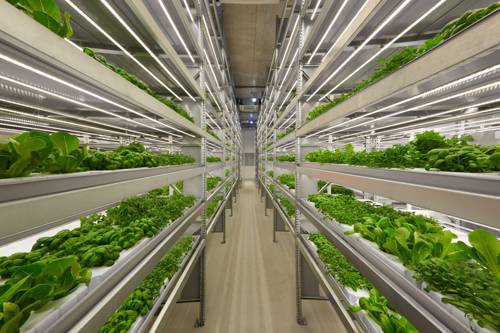
FAQ About Indoor Vertical Vegetable Farming

What is indoor vertical vegetable farming?
Indoor vertical vegetable farming is a method of agriculture where crops are grown in stacked layers or vertically inclined surfaces, often in controlled environments like buildings or shipping containers. This method maximizes space usage and is ideally suited for urban areas where land is scarce. The technique typically uses hydroponics, aeroponics, or aquaponics to provide nutrient-rich solutions to plants without traditional soil.

Why should I consider vertical farming indoors for growing vegetables?
Vertical farming indoors offers several advantages, including year-round crop production regardless of weather conditions, reduced water usage compared to traditional farming, minimized need for pesticides, and the ability to grow crops in urban areas close to consumers. This not only reduces transportation costs and emissions but also ensures fresh produce availability.

What vegetables are best suited for indoor vertical farming?
Certain vegetables thrive in an indoor vertical farming environment. Leafy greens like lettuce, spinach, and kale are popular due to their rapid growth and compact size. Herbs such as basil, mint, and cilantro also do well. Some fruiting vegetables, like cherry tomatoes and peppers, can be grown with the right vertical system and lighting.

How do I set up an indoor vertical farming system?
Setting up an indoor vertical farming system involves several steps: choosing a location with adequate light or providing artificial lighting, selecting the appropriate vertical farming method (hydroponics, aeroponics, etc.), and acquiring the necessary equipment like shelves, grow lights, and nutrient solutions. Adequate ventilation and humidity control systems are also essential for maintaining a healthy growth environment.

What is hydroponics in the context of vertical farming?
Hydroponics is a method of growing plants without soil by using a water-based nutrient-rich solution. In vertical farming, hydroponics allows for efficient nutrient delivery directly to plant roots, often resulting in faster growth and higher yields. This system can be easily integrated into a vertical setup, making it a popular choice for indoor vegetable farming.

What lighting is needed for indoor vertical farming?
Indoor vertical farming requires artificial lighting to replace natural sunlight. LED grow lights are commonly used because they are energy-efficient and can be tailored in spectrum to the needs of the plants. The lights should be meticulously placed to ensure even distribution and promote healthy growth across all layers of the vertical setup.

Can I grow root vegetables in an indoor vertical farm?
While it's possible to grow some root vegetables in an indoor vertical farm, it's less common due to space constraints and their typically longer growing periods. Smaller root vegetables like radishes and some types of carrots might be feasible with the right system adjustments. More commonly, vertical farms focus on leafy greens and herbs.

What are the typical costs involved in setting up a vertical farm indoors?
The cost of setting up an indoor vertical farm varies greatly depending on the scale and technology used. Expenses include grow lights, shelving or racks, hydroponic systems, climate control systems, seeds, and nutrient solutions. Initial setup can be costly, ranging from a few thousand dollars for a small home system to several hundreds of thousands for commercial operations. However, operational costs can decrease over time with improved efficiency.

How do I maintain an indoor vertical farm?
Maintenance of an indoor vertical farm involves regular monitoring of plant health, nutrient levels, and pH balance. Cleaning and sterilizing the system to prevent disease, managing pest control without harmful pesticides, and ensuring the lighting and climate systems are functioning properly are also key aspects. Consistent record-keeping helps in tracking progress and making necessary adjustments.

Is indoor vertical farming environmentally friendly?
Indoor vertical farming is generally considered to be environmentally friendly due to its efficient use of resources. It uses up to 95% less water than conventional agriculture and drastically reduces the need for pesticides. Furthermore, since it is often located near urban centers, it reduces the carbon footprint associated with transporting produce across long distances.

How does vertical farming impact crop yields?
Vertical farming often results in higher crop yields compared to conventional methods due to controlled conditions that promote optimal growth. Crops can be grown year-round, multiple harvests can be achieved annually, and nutrient delivery is optimized for growth efficiency. This method can produce yields several times higher per square foot than traditional farming.

What role does technology play in vertical farming?
Technology is integral to vertical farming, enhancing efficiency and yield. It involves precision agriculture components such as automated nutrient delivery systems, climate sensors, and LED grow lights. Moreover, advanced data analytics can forecast growth patterns, detect issues early, and optimize resource usage.

What are common challenges faced in indoor vertical farming?
Common challenges include high initial setup costs, technical complexities in system maintenance, and operational expenses related to energy consumption, particularly lighting. Additionally, it requires expertise in managing plant health and controlling the growing environment, which can be complex and labor-intensive.

Can indoor vertical farming systems be scaled for commercial use?
Yes, indoor vertical farming systems can be scaled for commercial production. Large-scale vertical farms are operational in many urban areas, taking advantage of their space efficiency and ability to deliver fresh produce with reduced transport costs. However, scaling up requires significant investment in technology and infrastructure.

How does aeroponics differ from hydroponics in vertical farming?
Aeroponics is similar to hydroponics but instead of submerging roots in a nutrient solution, it delivers nutrients by misting or spraying them onto the plant roots that are suspended in air. This method can use even less water than hydroponics and allows easier oxygen absorption by the roots, potentially leading to faster plant growth and higher yields.

What is the role of climate control in indoor vertical farming?
Climate control is essential in indoor vertical farming to maintain the optimal temperature, humidity, and CO2 levels for plant growth. Sophisticated systems may include automated heating, cooling, humidifying, and dehumidifying devices, as well as CO2 generators, ensuring consistent conditions to maximize growth and reduce disease risk.

Can indoor vertical farms host biodiversity?
Although indoor vertical farms focus on crop uniformity to maximize yield and efficiency, they can still promote biodiversity by cultivating diverse plant species in separate systems. However, maintaining multiple plant species requires careful management of each plant's specific growth conditions and nutrient needs.

Are there educational resources available for learning about vertical farming?
Yes, there are numerous educational resources available for those interested in vertical farming, ranging from online courses and webinars to books and research papers. Organizations like the Vertical Farming Association offer workshops and publications that cover both the basics and advanced topics in vertical agriculture.

What nutrient solutions are used in indoor vertical farming?
The nutrient solutions used in indoor vertical farming depend on the specific plants being grown but generally include a balanced mix of essential macro and micronutrients such as nitrogen, phosphorus, potassium, calcium, magnesium, and micro-elements like iron and manganese. These solutions are tailored to support the optimal growth of specific crops.

How sustainable is indoor vertical farming compared to traditional agriculture?
Indoor vertical farming is considered highly sustainable compared to traditional agriculture because it minimizes water usage, pesticide application, and arable land requirements. By optimizing resource use and reducing waste, it offers a scalable solution to food production in urban areas where conventional farming isn't feasible.
